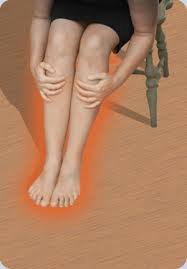What is Superficial Venous Thrombophlebitis?
Superficial venous thrombophlebitis (SVT) is defined as an abnormal process of inflammation and clotting of a vein located at the level of the skin or just below the skin surface. The condition is often referred to as phlebitis or vein thrombosis. The most common location of SVT is in the leg. Common symptoms of this condition are sudden onset of leg pain associated with redness, swelling, and tenderness of the skin and the soft tissues beneath the skin surface. There is often a tender hardened lump that is palpable beneath the skin surface.
What Causes Superficial Venous Thrombophlebitis
There are many possible causes of superficial venous thrombophlebitis. One of the most common cause is varicose veins of the legs. The reason that varicose veins often lead to phlebitis is because of the abnormal “pooling of blood” or stagnation of blood within the defective vein. Since varicose veins have dilated walls and defective valves inside them, there tends to be stagnation of blood flow within these veins. When the flow of blood slows and blood “pools,”this often leads to blood clots forming in these diseased veins.

After blood clots form, the human body sets up an inflammatory reaction inside the vein and within the vein wall that leads to pain, tenderness, swelling, and redness.
Other causes of SVT are trauma (such as a direct impact to the leg), surgery on any part of the body, prolonged immobility of a limb such as during travel, or infection. Another possible cause is abnormal thickening of the blood, referred to as a hyper-coagulable state. Some causes of hypercoagulability are genetic conditions referred to as genetic clotting disorders (such as Factor V Leiden mutation), malignancy, or hormone replacement therapy (such as oral contraceptives). Medical procedures such as insertion of an IV line or central vein catheter can also predispose to SVT.
What Testing is Needed for Superficial Venous Thrombophlebitis?
Typically an ultrasound of the leg veins is required. The purpose of this study is to determine how severe the blood clot is. The length of the clot and the location of the clot are critical pieces of information that help the vein physician to determine the appropriate treatment. The ultrasound also determines whether the blood clot is isolated to the superficial veins or whether the deep vein legs are involved as well. When the deep veins are involved with the process, then this is referred to as deep venous thrombosis or deep vein thrombphlebitis (DVT). DVT is much more serious than SVT. Determining whether DVT is present in the leg is of utmost importance in managing the condition. An experience vascular ultrasound technician or vascular physician should perform the ultrasound exam. Following treatment, a follow-up ultrasound examination is often recommended to confirm resolution of the clot. This follow-up ultrasound will also help to determine whether any further treatments are necessary.
What is the Treatment for Superficial Venous Thrombophlebitis?
This is best determined by a Vein Specialist, known as a vascular surgeon. If you believe that you may have SVT, immediately seek a physician consultation with a vascular surgeon. The seriousness of thrombosis involving the superficial venous system has long been underestimated. It is critical that an ultrasound be performed as soon as possible to determine whether a deep venous thrombosis (DVT) is present or if there is significant risk of development of a DVT. For more severe cases of SVT, especially those cases in which there is blood clot in close proximity to a deep vein, systemic anticoagulation with a prescription blood thinner medication may be necessary. Other treatments for SVT may include a prescription compression stocking on the leg (knee-high or thigh-high), anti-inflammatories, aspirin, exercise, and warm compresses. It is often necessary to undergo some hematological blood test studies to assess for any possible coagulation disorder that may have caused the blood clot to form. If your doctor feels that there is a possibility that one of your previous medications (such as hormone therapy) may have contributed to your condition, he may recommend discontinuing the medication. In rare instances, a minor procedure to remove the clot may be necessary.
In addition, your doctors will search for any underlying anatomic condition that may have lead to your blood clot forming. Your physician will evaluate you for varicose veins or venous reflux disease, which can predispose you to SVT. In some circumstances you may benefit from treatment of varicose vein disease to prevent recurrenct of blood clots. Seek a vein specialist to properly assess your condition and make appropriate recommendations.
Prognosis and Long-Term Managment
The prognosis of people with superficial thrombophlebitis depends on its etiology, the extent of involvement, and whether there was extension of blood clot into the deep venous system. The prognosis will also depend on whether there is an underlying blood coagulation disorder and whether there is a chronic persistent anatomical disorder of the veins. Typically, once an episode of SVT occurs there is a much higher incidence of another future episode of the same process. When varicose veins and venous reflux disease have caused the SVT, it is generally advised to have the abnormal veins treated with intervention in order to prevent future SVT recurrence.
If you suspect that you may have developed superficial venous thrombophlebitis, call our Vein Center at (512) 220-5401.


